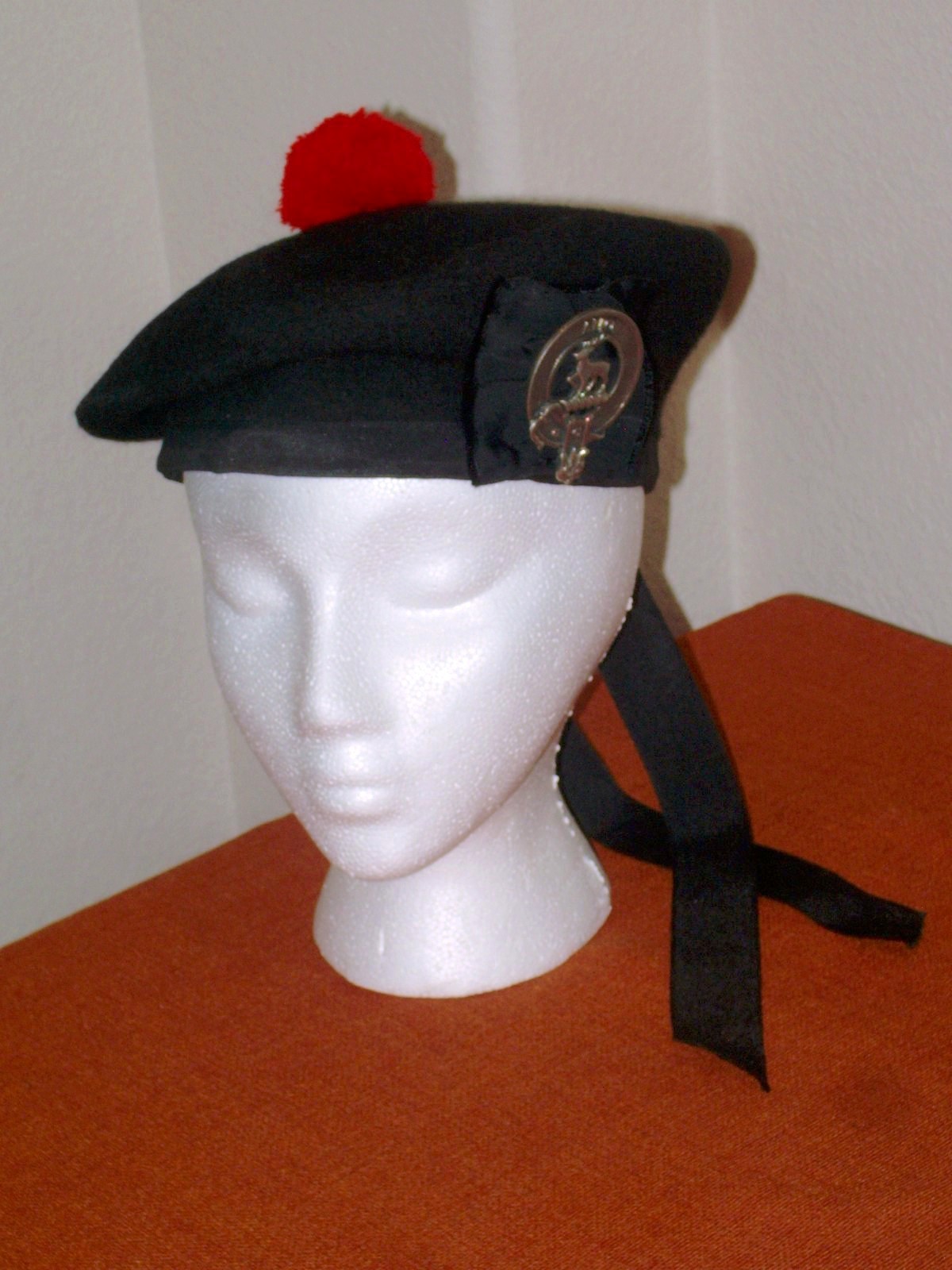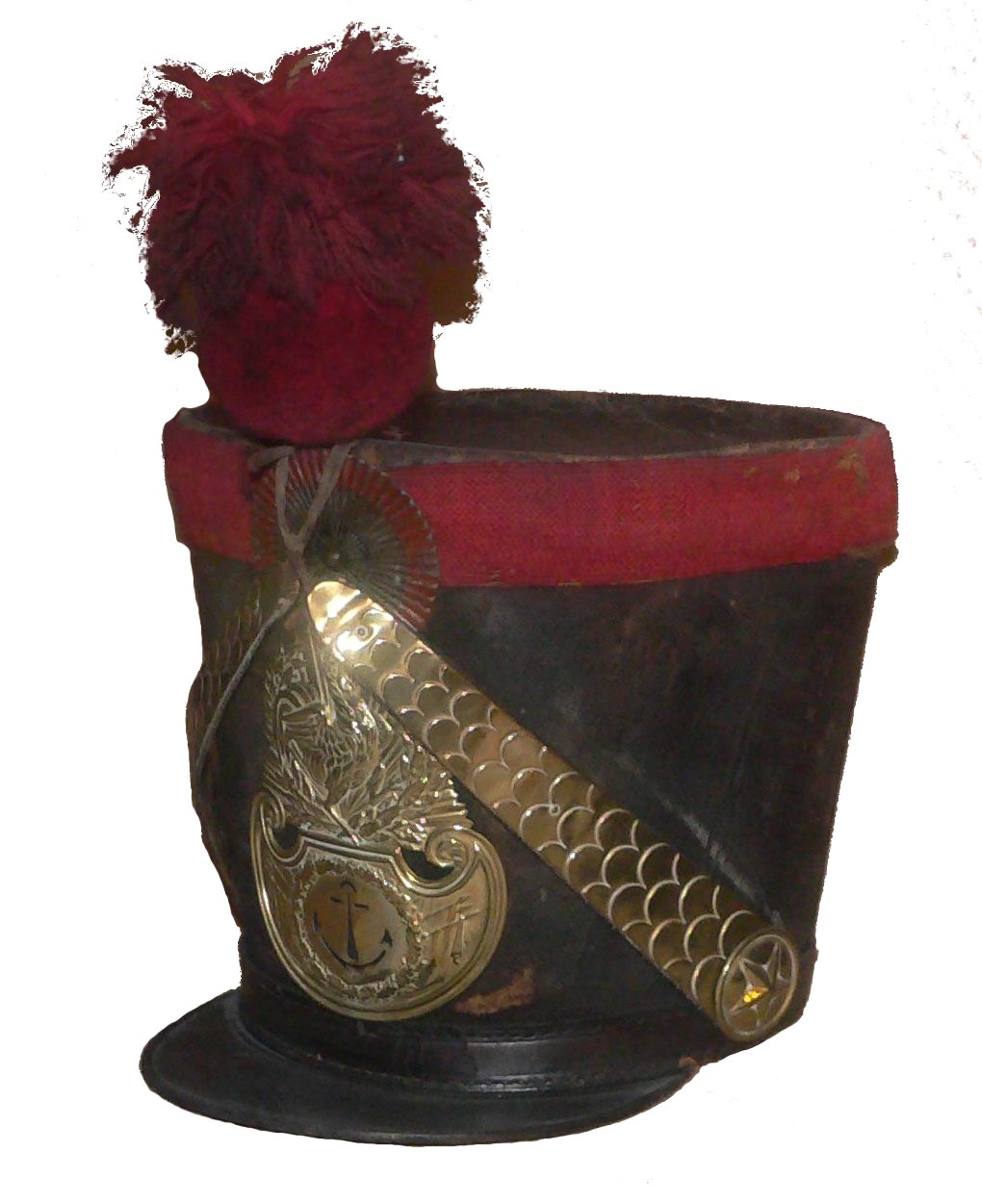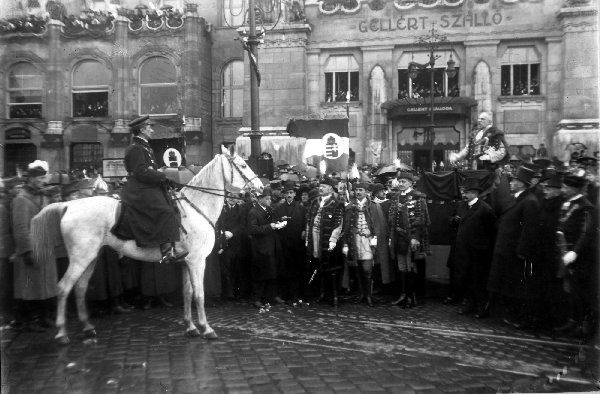|
Forage Cap
Forage cap is the designation given to various types of military undress, fatigue or working headwear. These vary widely in form, according to country or period. The coloured peaked cap worn by the modern British Army for parade and other dress occasions is still officially designated as a forage cap. History In the 18th century, forage caps were small cloth caps worn by British cavalrymen when undertaking work duties such as foraging for food for their horses. The term was later applied to undress caps worn by men of all branches and regiments as a substitute for the full dress headdress. Usage French Army During the French Revolutionary Wars, French soldiers made their own forage caps from the cloth of old coats. Known as the , these caps resembled a nightcap and were also worn by Santa Anna's army during the Mexican War. From the 1840s until World War I, French line infantry wore the blue and red kepi, but in 1915, the was reintroduced as a horizon blue garrison cap. Worn ... [...More Info...] [...Related Items...] OR: [Wikipedia] [Google] [Baidu] |
Ski Cap
The ski cap is a type of field cap used by several German-speaking or German-influenced armed forces since the late 19th century. The design originates from imperial Austria-Hungary, but is best known for its widespread use as M43 field cap () used by the Nazi Germany, German Wehrmacht and SS during World War II. A similar design is used in Germany as the distinguishing headgear of the , the only differences being the bill was slightly extended and the top panel of the hat had a smaller circumference, giving it slightly sloped-in sides. The design and its successors still in use today are the German counterparts to the American patrol cap or utility cover. Variants There are several variants of the ski cap, starting with the 's ski cap. This was the first in the family of caps, and was recognized by a high peak, a teardrop shaped top, a short bill, and a small skirt that folds down to protect the ears in cold. All had a small edelweiss or a grouping of leaves, depending on the u ... [...More Info...] [...Related Items...] OR: [Wikipedia] [Google] [Baidu] |
Side Cap
A side cap is a military cap that can be folded flat when not being worn. It is also known as a garrison cap or flight cap in the United States, wedge cap in Canada, or field service cap in the United Kingdom. In form the side cap is comparable to the glengarry, a folding version of the Scottish military bonnet. It has been associated with various military forces since the middle of the 19th century, as well as various civilian organizations. Australia All ranks of the Royal Australian Air Force (RAAF) are entitled to wear the blue garrison cap with appropriate cap badge as an optional item with General Purpose Uniform (GPU), Service Dress (SD) and Flying Dress (FD) uniforms. The piping of the garrison cap for air officers is light blue, the piping for all other ranks is solid blue. The RAAF is the only branch of the Australian Defence Force entitled to wear garrison caps. Canada Army In the Canadian Armed Forces, the field service cap () is defined by the Canadian Forces Dr ... [...More Info...] [...Related Items...] OR: [Wikipedia] [Google] [Baidu] |
Glengarry
The Glengarry bonnet is a traditional Scots cap made of thick-milled woollen material, decorated with a toorie on top, frequently a rosette cockade on the left side, and ribbons hanging behind. It is normally worn as part of Scottish military or civilian Highland dress, either formal or informal, as an alternative to the Balmoral bonnet or Tam o' Shanter. History Traditionally, the Glengarry bonnet is said to have first appeared as the head dress of the Glengarry Fencibles when they were formed in 1794 by Alexander Ranaldson MacDonell of Glengarry, of Clan MacDonell of Glengarry. MacDonell, therefore, is sometimes said to have invented the Glengarry – but it is not clear whether early pictures of civilians or Fencible infantry show a true glengarry, capable of being folded flat, or the standard military bonnet of the period merely cocked into a more "fore-and-aft" shape. The first use of the classic, military glengarry may not have been until 1841, when it is said to h ... [...More Info...] [...Related Items...] OR: [Wikipedia] [Google] [Baidu] |
Kilmarnock Bonnet
The Balmoral bonnet (also known as a Balmoral cap or Kilmarnock bonnet) is a traditional Scottish hat that can be worn as part of formal or informal Highland dress. Developed from the earlier blue bonnet, dating to at least the 16th century, it takes the form of a knitted, soft wool cap with a flat crown. It is named after Balmoral Castle, a royal residence in Scotland. It is an alternative to the similar and related (informal) Tam o' Shanter cap and the (formal or informal) Glengarry bonnet. Design Originally with a voluminous crown, today, the bonnet is smaller, made of finer cloth, and tends to be dark blue, black, or Lovat green. Ribbons in or attached to the back of the band (originally used to secure the bonnet tightly) are sometimes worn hanging from the back of the cap. A regimental or clan badge is worn on the left-hand side, affixed to a silk or grosgrain ribbon cockade (usually black, white, or red), with the bonnet usually worn tilted to the right to display thi ... [...More Info...] [...Related Items...] OR: [Wikipedia] [Google] [Baidu] |
Shako
A shako (, , or ) is a tall, cylindrical military cap, usually with a visor, and sometimes tapered at the top. It is usually adorned with an ornamental plate or Cap badge, badge on the front, metallic or otherwise; and often has a feather, hackle, or pompom attached at the top. Extensively used as an item of military headgear during the nineteenth and early twentieth centuries, the shako now survives as part of some ceremonial uniforms. Origins The word ''shako'' originated from the Hungarian language, Hungarian name for the ''peak'', which Hungarian border soldiers () added around 1790 to their previously visorless stovepipe-style hats. Originally these hats were part of the clothing commonly worn by shepherds, before being added to the uniform of the Hungary, Hungarian hussar in the early 18th century. Other spellings include ''chako'', ''czako'', ''sjako'', ''schako'', ''schakot'', and ''tschako''. From 1800 on, the shako became a common military Headgear, headdress worn by ... [...More Info...] [...Related Items...] OR: [Wikipedia] [Google] [Baidu] |
War Office
The War Office has referred to several British government organisations throughout history, all relating to the army. It was a department of the British Government responsible for the administration of the British Army between 1857 and 1964, at which point its functions were transferred to the new Ministry of Defence (United Kingdom), Ministry of Defence (MoD). This article contains text from this source, which is available under th Open Government Licence v3.0 © Crown copyright It was equivalent to the Admiralty (United Kingdom), Admiralty at that time, which was responsible for the Royal Navy (RN), and (much later) the Air Ministry, which oversaw the Royal Air Force (RAF). The name 'Old War Office' is also given to the former home of the department, located at the junction of Horse Guards Avenue and Whitehall in central London. The landmark building was sold on 1 March 2016 by HM Government for more than British pound, £350 million, on a 250-year lease for conversion int ... [...More Info...] [...Related Items...] OR: [Wikipedia] [Google] [Baidu] |
M1 Garand
The M1 Garand or M1 rifleOfficially designated as U.S. rifle, caliber .30, M1, later simply called Rifle, Caliber .30, M1, also called US Rifle, Cal. .30, M1 is a semi-automatic rifle that was the service rifle of the United States Army, U.S. Army during World War II and the Korean War. The rifle is chambered for the .30-06 Springfield cartridge and is named after its Canadian Americans, Canadian-American designer, John Garand. It was the first standard-issue autoloading rifle for the United States. By most accounts, the M1 rifle performed well. General George S. Patton called it "the greatest battle implement ever devised". The M1 replaced the (bolt-action) M1903 Springfield as the U.S. service rifle in 1936, and was itself replaced by the (selective fire, selective-fire) M14 rifle on 26 March 1958. Pronunciation Sources differ on the pronunciation of the M1 Garand. Some, such as General Julian Hatcher, Julian Hatcher's ''The Book of the Garand'' (1948), give , identical to ... [...More Info...] [...Related Items...] OR: [Wikipedia] [Google] [Baidu] |
Royal Hungarian Army
The Royal Hungarian Army (, ) was the name given to the land forces of the Kingdom of Hungary (1920–1946), Kingdom of Hungary in the period from 1922 to 1945. Its name was inherited from the Royal Hungarian Honvéd which went under the same Hungarian title of ''Magyar Királyi Honvédség'' from 1867 to 1918. Initially restricted by the Treaty of Trianon to 35,000 men, the army was steadily upgraded during the 1930s and fought on the side of the Axis powers during World War II. History Background As a vanquished power in World War I, Hungary had hardly grown at all in the immediate post-war years thanks to the territorial demands of its old and new neighbouring states, the Kingdom of Romania, First Czechoslovak Republic, Czechoslovakia and the Kingdom of Serbs, Croats and Slovenes. The Hungarian Red Army that was formed during the period of the Hungarian Soviet Republic, in which many world war veterans enlisted, was defeated by the allied armies in the Hungarian–Romanian ... [...More Info...] [...Related Items...] OR: [Wikipedia] [Google] [Baidu] |
Austro-Hungarian Empire
Austria-Hungary, also referred to as the Austro-Hungarian Empire, the Dual Monarchy or the Habsburg Monarchy, was a multi-national constitutional monarchy in Central Europe between 1867 and 1918. A military and diplomatic alliance, it consisted of two sovereign states with a single monarch who was titled both the Emperor of Austria and the King of Hungary. Austria-Hungary constituted the last phase in the constitutional evolution of the Habsburg monarchy: it was formed with the Austro-Hungarian Compromise of 1867 in the aftermath of the Austro-Prussian War, following wars of independence by Hungary in opposition to Habsburg rule. It was dissolved shortly after Hungary terminated the union with Austria in 1918 at the end of World War 1. One of Europe's major powers, Austria-Hungary was geographically the second-largest country in Europe (after Russia) and the third-most populous (after Russia and the German Empire), while being among the 10 most populous countries worldwide. T ... [...More Info...] [...Related Items...] OR: [Wikipedia] [Google] [Baidu] |
Republic Of Austria
Austria, formally the Republic of Austria, is a landlocked country in Central Europe, lying in the Eastern Alps. It is a federation of nine Federal states of Austria, states, of which the capital Vienna is the List of largest cities in Austria, most populous city and state. Austria is bordered by Germany to the northwest, the Czech Republic to the north, Slovakia to the northeast, Hungary to the east, Slovenia and Italy to the south, and Switzerland and Liechtenstein to the west. The country occupies an area of and has Austrians, a population of around 9 million. The area of today's Austria has been inhabited since at least the Paleolithic, Paleolithic period. Around 400 BC, it was inhabited by the Celts and then annexed by the Roman Empire, Romans in the late 1st century BC. Christianization in the region began in the 4th and 5th centuries, during the late Western Roman Empire, Roman period, followed by the arrival of numerous Germanic tribes during the Migration Period. A ... [...More Info...] [...Related Items...] OR: [Wikipedia] [Google] [Baidu] |
Austrian Armed Forces
The Austrian Armed Forces () are the combined military forces of Austria. The military consists of 16,000 active-duty personnel and 125,600 reservists. The military budget is 1.0% of national GDP (including pensions) or €3.317 billion (2023,without pensions). History Interwar In 1918, the Republic of German-Austria established a military known as the ("People's Defence"). ''Volkswehr'' forces took part in military confrontations with Royal Yugoslav Army troops which occupied parts of Carinthia that Austria claimed as its own. In 1920, after the Republic of German-Austria transitioned into the First Austrian Republic, the new regime changed the military's name to the ("Federal Army"), which it has been known by ever since. In 1938, officers led by Alfred Jansa developed a military operation plan to defend against a potential invasion by Nazi Germany, which ultimately went unused due to a lack of political willpower when Austria was annexed by the Germans ... [...More Info...] [...Related Items...] OR: [Wikipedia] [Google] [Baidu] |









